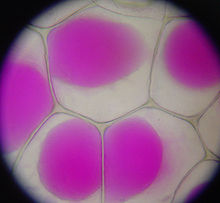Lysis
Lysis(/ˈlaɪsɪs/LY-sis) is the breaking down of themembraneof acell,often byviral,enzymic,orosmotic(that is, "lytic"/ˈlɪtɪk/LIT-ik) mechanisms that compromise its integrity. A fluid containing the contents of lysed cells is called alysate.Inmolecular biology,biochemistry,andcell biologylaboratories,cell culturesmay be subjected to lysis in the process of purifying their components, as inprotein purification,DNA extraction,RNA extraction,or in purifyingorganelles.
Many species ofbacteriaare subject to lysis by the enzymelysozyme,found in animalsaliva,egg white,and othersecretions.[1]Phage lytic enzymes (lysins) produced duringbacteriophageinfection are responsible for the ability of these viruses to lyse bacterial cells.[2]Penicillinand relatedβ-lactamantibioticscause the death of bacteria through enzyme-mediated lysis that occurs after the drug causes the bacterium to form a defectivecell wall.[3]If the cell wall is completely lost and the penicillin was used ongram-positive bacteria,then the bacterium is referred to as aprotoplast,but if penicillin was used ongram-negative bacteria,then it is called aspheroplast.
Cytolysis
[edit]Cytolysis occurs when a cell bursts due to an osmotic imbalance that has caused excess water to move into the cell.
Cytolysis can be prevented by several different mechanisms, including thecontractile vacuolethat exists in someparamecia,which rapidly pump water out of the cell. Cytolysis does not occur under normal conditions in plant cells because plant cells have a strong cell wall that contains the osmotic pressure, orturgor pressure,that would otherwise cause cytolysis to occur.
Oncolysis
[edit]Oncolysis is the destruction ofneoplasticcells or of atumour.
The term is also used to refer to the reduction of anyswelling.[4]
Plasmolysis
[edit]
Plasmolysis is the contraction ofcellswithin plants due to the loss of water throughosmosis.In ahypertonicenvironment, the cell membrane peels off thecell walland thevacuolecollapses. These cells will eventually wilt and die unless the flow of water caused by osmosis can stop the contraction of thecell membrane.[5]
Immune response
[edit]Erythrocytes' hemoglobin releasefree radicalsin response to pathogens when lysed by them. This can damage the pathogens.[6][7]
Applications
[edit]Cell lysis is used in laboratories to break open cells and purify or further study their contents. Lysis in the laboratory may be affected byenzymesordetergentsor otherchaotropic agents.Mechanical disruption of cell membranes, as by repeated freezing and thawing,sonication,pressure, orfiltrationmay also be referred to as lysis. Many laboratory experiments are sensitive to the choice of lysis mechanism; often it is desirable to avoid mechanicalshear forcesthat would denature or degrade sensitive macromolecules, such asproteinsandDNA,and different types of detergents can yield different results. The unprocessed solution immediately after lysis but before any further extraction steps is often referred to as acrude lysate.[8][9]
For example, lysis is used inwesternandSouthern blottingto analyze the composition of specificproteins,lipids,andnucleic acidsindividually or ascomplexes.Depending on thedetergentused, either all or some membranes are lysed. For example, if only thecell membraneis lysed thengradient centrifugationcan be used to collect certainorganelles.Lysis is also used forprotein purification,DNA extraction,andRNA extraction.[8][9]
Methods
[edit]Chemical lysis
[edit]This method uses chemical disruption. It is the most popular and simple approach. Chemical lysis chemically deteriorates/solubilizes the proteins and lipids present within the membrane of targeted cells.[10]
Acoustic lysis
[edit]This method uses ultrasonic waves to generate areas of high and low pressure which causes cavitation and in turn, cell lysis. Though this method usually comes out clean, it fails to be cost effective and consistent.[11]
Mechanical lysis
[edit]This method uses physical penetration to pierce or cut a cell membrane.[12]
Enzymatic lysis
[edit]This method uses enzymes such as lysozyme or proteases to disintegrate the cell membrane.[13]
See also
[edit]References
[edit]- ^P. Jollès, ed. (1996).Lysozymes--model enzymes in biochemistry and biology.Basel: Birkhäuser Verlag. pp. 35–64.ISBN978-3-7643-5121-2.
- ^Nelson, D.; Loomis, L.; Fischetti, V. A. (20 March 2001)."Prevention and elimination of upper respiratory colonization of mice by group A streptococci by using a bacteriophage lytic enzyme".Proceedings of the National Academy of Sciences.98(7): 4107–12.Bibcode:2001PNAS...98.4107N.doi:10.1073/pnas.061038398.PMC31187.PMID11259652.
- ^Scholar, E. M.; Pratt, W. B. (2000).The antimicrobial drugs(2nd ed.).Oxford University Press.pp.61–64.ISBN978-0-19-975971-2.
- ^"Oncolysis".Medical Dictionary.Farlex.Retrieved27 March2013.
- ^"Wiley InterScience: Journals: New Phytologist".New Phytologist.126:571–591.doi:10.1111/j.1469-8137.1994.tb02952.x.Archived fromthe originalon May 22, 2011.Retrieved2008-09-11.
- ^Shobana Kesava (1 September 2007)."Red blood cells do more than just carry oxygen. New findings by NUS team show they aggressively attack bacteria too"(PDF).The Straits Times.Archived fromthe original(PDF)on 2009-02-20 – via Department of Biological Sciences, National University of Singapore.
- ^Jiang, N; Tan, NS; Ho, B; Ding, JL (October 2007)."Respiratory protein-generated reactive oxygen species as an antimicrobial strategy"(PDF).Nature Immunology.8(10): 1114–22.doi:10.1038/ni1501.PMID17721536.S2CID11359246.Archived(PDF)from the original on Jan 12, 2024.
- ^abThermo Scientific Pierce Cell Lysis Technical Handbook(PDF)(2 ed.). Thermo Scientific.
- ^ab"Protein Expression and Purification Core Facility: Protein Purification: Extraction and Clarification".European Molecular Biology Laboratory.Retrieved17 March2015.
- ^Park, Seung-min; Sabour, Andrew F; Ho Son, Jun; Hun Lee, Sang; Lee, Luke (2014)."Toward Integrated Molecular Diagnostic System (iMDx): Principles and Applications".IEEE Transactions on Bio-Medical Engineering.61(5): 1506–1521.doi:10.1109/TBME.2014.2309119.PMC4141683.PMID24759281.
- ^Park, Seung-min; Sabour, Andrew F; Ho Son, Jun; Hun Lee, Sang; Lee, Luke (2014)."Toward Integrated Molecular Diagnostic System (iMDx): Principles and Applications".IEEE Transactions on Bio-Medical Engineering.61(5): 1506–1521.doi:10.1109/TBME.2014.2309119.PMC4141683.PMID24759281.
- ^Park, Seung-min; Sabour, Andrew F; Ho Son, Jun; Hun Lee, Sang; Lee, Luke (2014)."Toward Integrated Molecular Diagnostic System (iMDx): Principles and Applications".IEEE Transactions on Bio-Medical Engineering.61(5): 1506–1521.doi:10.1109/TBME.2014.2309119.PMC4141683.PMID24759281.
- ^Danaeifar, Mohsen (November 2022)."New horizons in developing cell lysis methods: A review".Biotechnology and Bioengineering.119(11): 3007–3021.doi:10.1002/bit.28198.ISSN0006-3592.PMID35900072.S2CID251132821.
